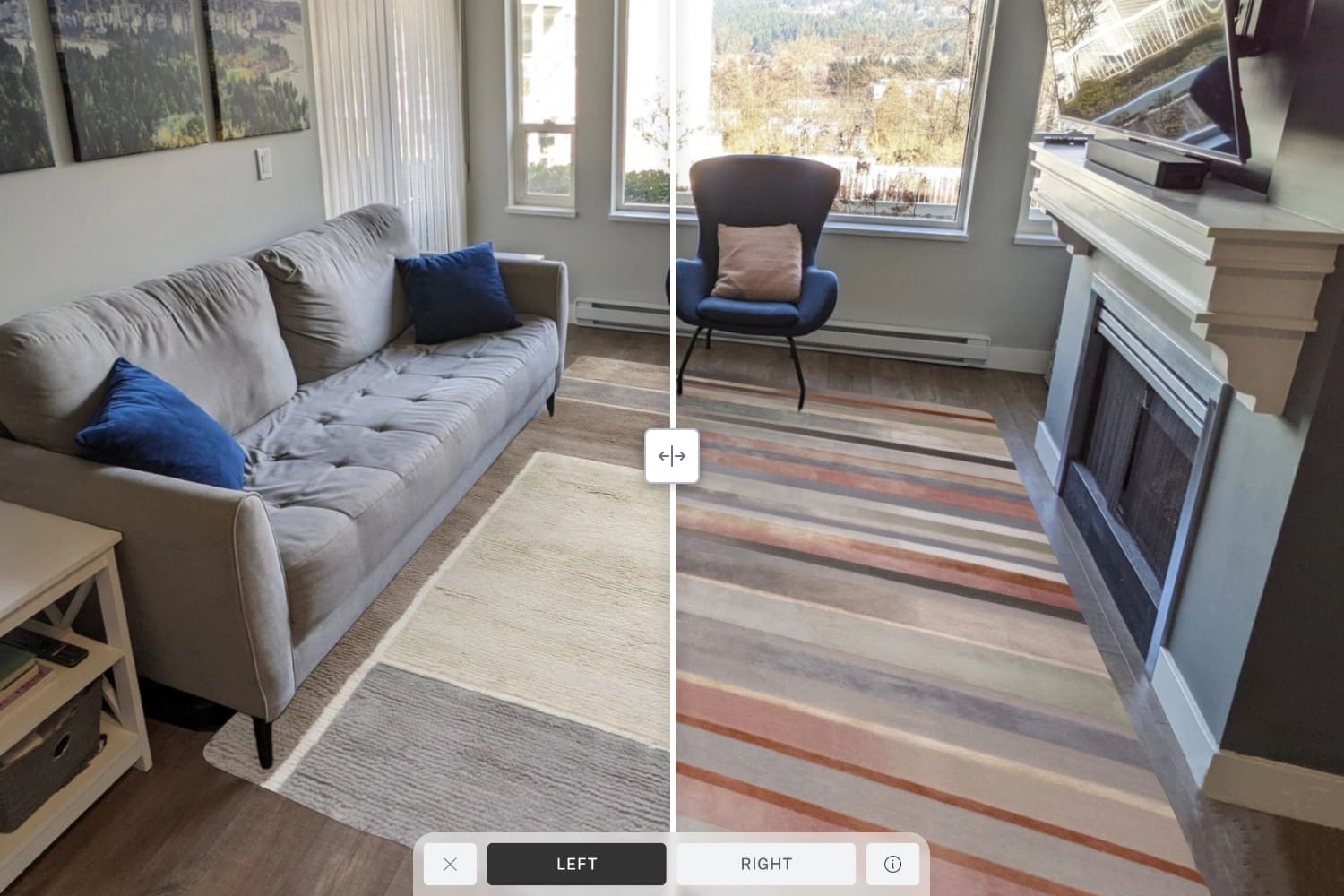As a big-box retailer, your greatest strength — a comprehensive selection of products and services — can also be one of your greatest challenges. The breadth of your offerings means there are bound to be diverse needs across various teams, which can sometimes lead to competing priorities and a lack of synergy.
It’s almost inevitable.
Now, imagine if there was an all-in-one technology solution — designed specifically with the home improvement industry in mind — that offers unparalleled support across your entire business.
Enter room visualization. By allowing consumers to see your products in their rooms before making a purchase, room visualization technology empowers immersive shopping experiences, confident purchase decisions, and more conversions. From marketing to in-store sales, e-commerce, merchandising and more, here are some of the different teams within big-box stores benefiting from room visualization.
Marketing
If you were to ask your marketing team to list some of their main goals, you’ll almost certainly get a variation of these answers:
- Increase brand awareness and engagement
- Build customer relationships and loyalty
- Generate leads
- Drive sales
Room visualization ticks all of these boxes.
Since increasing revenue and sales was the top priority for marketing leaders in 2023, we’ll start there. At its core, a room visualizer is meant to instill customer confidence and simplify the product selection process, which ultimately helps drive sales.
Consider a customer wanting to find the perfect paint for their living room. With room visualization, they can apply your paints to their walls with just a few clicks and see how the different colours look with their existing decor, which would be very difficult to picture otherwise. Placing your product in a customer’s home eliminates the guesswork and helps inspire an emotional connection. When you consider that 95% of all purchasing decisions are driven by emotion, this can have a direct impact on your bottom line.
The potential for revenue generation is even greater with advanced room visualization technology that can display multiple surfaces in a customer’s room simultaneously, including flooring, countertops, and wall coverings. Now, you’ll be helping customers redesign their entire room, opening up the opportunity to cross-sell into different product categories and increase the total value of an order.
Room visualization is far more than a selling tool, however. From highlighting the visualization experience within their social media content and video ads to running contests that incentivize visualizer usage, there are many different ways marketing teams are using room visualization to generate leads and increase brand awareness and engagement.
Tile manufacturer, Caesar Ceramiche, has seen particular success with its digital marketing efforts.
“Since launching with Roomvo, we’ve increased the number of leads we’re generating,” said Alessio Testa, digital marketing specialist at Caesar Ceramiche. “It’s easier to get clicks on our ads when we’re promoting the room visualizer. We’ve had tremendous feedback from consumers so far. It’s genuinely making a difference in helping them envision our products in their spaces.”
In an environment where customers have higher expectations and more options than ever before, two out of three business leaders view increasing brand reputation and loyalty as their top priority in 2024.
Room visualization is certain to help your marketing team achieve these goals, providing an exceptional shopping experience that sets your home improvement store apart from the competition and ensures your customers keep coming back for more.
E-commerce
When a customer walks into your brick-and-mortar storefront, your sales staff is there to answer their questions and, ideally, guide them closer to a sale.
But what about when they land on your e-commerce website?
Millennials and DIYers, in particular, are searching for products on home improvement store websites – more than any other online source. When you consider that millennials complete the most home improvement projects per year and spend around 30% more per project than other generations, this presents a significant opportunity to turn those browsers into buyers.
Room visualization helps your e-commerce team do exactly that.
Online flooring retailer Flooret saw its sales increase by more than 20% in the four months following the launch of its Roomvo visualizer. Bounce rates dropped significantly while visitor time on site more than doubled, leading co-founder Michael Maddux to appreciate Roomvo as one of the best investments the company has made.
“It’s a very modern solution,” said Maddux. “It was simple to set up and intuitive for our site visitors to use. The feedback we are getting is that the vast majority of our customers love it.”
FlooringSupplies.co.uk, the first online flooring retailer in the UK, had a similar experience, achieving 2.7x more conversions when customers shop with the Roomvo visualizer.
By giving them the ability to view your products in their homes, it becomes much easier to keep customers on your website. Then, it’s a matter of moving them through the sales funnel. Roomvo enables this by seamlessly integrating with product pages and offering multiple CTA options within the visualizer. The Home Depot, for instance, has a “See This in My Room” button on its product pages, which opens up the corresponding product in the visualizer. After seeing the product come to life in their space, customers can then add it to their cart or order a sample within the same user experience.
At the end of the day, room visualization arms your e-commerce team with an integrated platform that fosters a fun and frictionless online shopping experience, keeping customers highly engaged while increasing the potential for conversion.
Merchandising
Although it may be a lesser-known benefit, home improvement brand teams are increasingly using consumer insights gleaned from their room visualizers to inform merchandising strategies. This applies to how your merchandising teams are selecting products, as well as displaying them in-store and online.
Take Arley Wholesale Inc., for instance. The leading tile, stone, and flooring distributor of the U.S. East Coast, Arley tracks the popularity of colours and products within the Roomvo PRO analytics portal and uses those insights to proactively adjust inventory to meet upcoming demands.
“Slate was out of fashion for a long time,” said Arley Wholesale president, Scott Levy. “All of a sudden, I see on the visualization platform that the popularity of slate is increasing again. That told me a trend was coming, so I could go out and fill the pipeline with this product.”
Leading tile manufacturer, Dal-Tile, meanwhile, analyzes how customers are grouping products together within their Roomvo visualizer, and which of their curated product pairings are resonating with their target audience. This allows them to continuously evaluate how best to showcase their products in-store and online, based on what the customers are actually telling them.
“If they’re selecting a specific countertop, what other options are they pairing with it?” said Bobbie Alonzo, senior director of digital marketing at Dal-Tile. “And which product groupings are getting selected the most? If there are particular product groupings that aren’t really working — where people aren’t really using those combinations — maybe we replace them with others.”
Coupled with your sales data and website statistics, room visualizer insights provide a more comprehensive understanding of consumer preferences and behaviours, which will be of significant value to your merchandising (and business intelligence) teams.
But there’s more.
Room visualization can also enhance the finer details of visual merchandising. For example, many retailers affix Roomvo QR codes to their product displays and samples. These QR codes, when scanned with a cellphone, directly link to corresponding products within the room visualizer, enabling customers to envision products in their home without even leaving your store.
Better still, retailers can link these QR codes to the Roomvo Kiosk, a touchscreen terminal that can visualize products in your customer’s home before they’ve even left the store.
Sales
Despite the rise of online shopping, most home improvement purchases are still happening in-store. This is often where you’ll encounter your most motivated shoppers. Room visualization can help get them over the line, serving as the ultimate closing tool for your retail sales associates.
LL Flooring has embraced this approach as part of its residential design consultations. Each sales advisor is equipped with the room visualizer on an iPad, and customers are encouraged to bring in a photo of their room so they can explore various designs tailored to their space. The result? 3.7x more conversions.
“The store associates say it is a great closing tool,” said Charles Tyson, president and CEO of LL Flooring. “Shoppers just love it since it takes the guesswork out of selecting the perfect floor for their space.”
For home improvement retailers, a lot of the magic happens on the sales floor. Integrating room visualization within your sales process not only keeps your customers on the floor longer but also fosters more meaningful conversations with your sales team. In other words, it gives them the best possible chance to do their job, which is to sell more products and send your customers home happy.
Real-world business results
As the home improvement retail industry continues to evolve, big-box stores are faced with a number of challenges. More competition from e-commerce giants. Changing consumer expectations. Higher costs … for pretty much everything. By enhancing the customer experience, optimizing operations, and driving sales, room visualization addresses these challenges head-on, serving as an innovative solution that will help get the most out of every facet of your business.
Written by:
-

Farhan Devji is a published author and content writer who’s written for some of Canada’s biggest newspapers and worked in communications/marketing for close to a decade. His new book, Alphonso Davies: A New Hope, was published in May 2023 with ECW Press.






